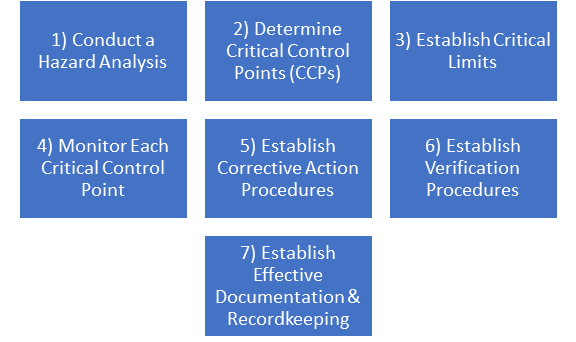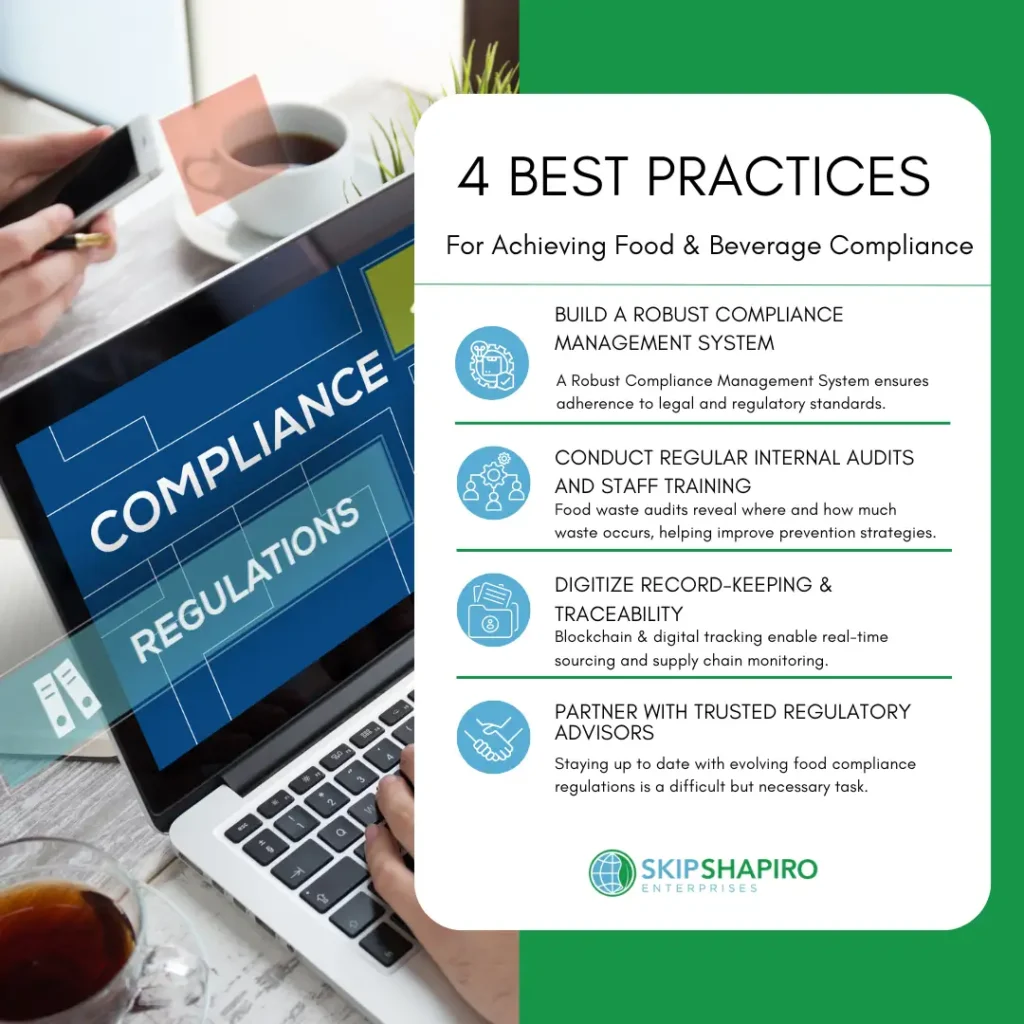Compliance in the food and beverage industry is directly tied to consumer trust, brand protection, and public health, making it absolutely essential.
A recent multi-state outbreak of Listeria infections traced to pasta meals—which led to four deaths—shows just how high the stakes can be when safety standards aren’t upheld.
That said, ensuring food and beverage safety should be a top priority for food-related establishments, where compliance is key in everything from sourcing and manufacturing to labeling, packaging, distribution, and waste management in the beverage industry.
This article covers everything you need to know about food and beverage regulatory compliance, including key regulations, common challenges, and best practices for achieving full compliance across markets.
Key Takeaways
- In addition to protecting consumer safety, food and beverage regulatory compliance helps companies prevent costly recalls and fines while strengthening brand reputation and export readiness, making it a beneficial solution on all fronts.
- The U.S. Food and Drug Administration is responsible for protecting the public health by ensuring the safety, efficacy, and security of human and veterinary drugs, biological products, and medical devices.
- Hazard Analysis and Critical Control Points is an internationally recognized system for identifying, managing, and controlling significant hazards associated with food production.
- The European Union enforces strict food labeling rules that require an ingredients list, the quantity of certain ingredients, and clear allergen information to help consumers make informed choices.
- Food and beverage regulatory compliance also applies to imports and exports, such as meeting the destination country’s safety and quality standards, providing proper labeling in the required language, and completing all customs documentation.
What Is Food and Beverage Regulatory Compliance?
Food and beverage regulatory compliance means meeting legal and safety standards across production, labeling, and distribution to ensure products are safe, transparent, and trustworthy.
In addition to protecting consumer safety, food and beverage regulatory compliance helps companies prevent costly recalls and fines while strengthening brand reputation and export readiness, making it a beneficial solution on all fronts.
To ensure safety across different states and markets, multiple federal and international agencies govern various aspects of the food and beverage supply chain. For instance, there is a Massachusetts food waste ban, regulations for large food waste generators in NJ, and other nationwide and international standards.
Key Food and Beverage Regulations Every Business Should Know
To better understand food compliance regulations, let’s look at the major frameworks, standards, and agencies.
1. FDA and FSMA Requirements (U.S.)
The U.S. Food and Drug Administration, or FDA, is responsible for protecting the public health by ensuring the safety, efficacy, and security of human and veterinary drugs, biological products, and medical devices.
As part of these FDA food safety standards, the agency introduced the FDA Food Safety Modernization Act, or FSMA, which shifts the focus from responding to foodborne illness to preventing it. Businesses often rely on an FSMA compliance checklist to ensure they meet key requirements.
To implement FSMA, the FDA has implemented several rules, such as Produce Safety, Pre-Harvest Agricultural Water, Food Traceability, and more.
2. GFSI Compliance and HACCP Standards
The Global Food Safety Initiative, or GFSI, collaborates with the world’s leading consumer goods companies to help ensure safe food for people everywhere. Their motto is that they collaborate across borders and barriers, helping communities across the globe access safe food.
A key part of this effort is the adoption of Hazard Analysis and Critical Control Points (HACCP), an internationally recognized systematic method of identifying, managing, and controlling significant hazards associated with the manufacture of food.

In fact, HACCP training is required under many GFSI schemes, demonstrating a commitment to building food safety systems that can effectively identify risks, implement preventive measures, and ensure compliance.
*GFSI recently discussed the role of digital HACCP in modern food safety management.
3. EU Food Safety and Labeling Laws
The EU food safety policy and action focuses on 4 main areas of protection: food hygiene, animal health, plant health, and contaminants and residues.
They also have a Rapid Alert System for Food and Feed, which was established to ensure the exchange of information between member countries to support swift reaction by food safety authorities in case of risks to public health resulting from the food chain.
Even more, the European Union enforces strict food labeling rules that require an ingredients list, the quantity of certain ingredients, and clear allergen information to help consumers make informed choices.
4. Import/Export and Trade Compliance
Food and beverage regulatory compliance also applies to imports and exports, such as meeting the destination country’s safety and quality standards, providing proper labeling in the required language, and completing all customs documentation.
For instance, imported food products are subject to FDA inspection when offered for import at U.S. ports of entry, while the EU enforces strict checks under its food safety and labeling regulations.
Common Compliance Challenges in the Food & Beverage Industry
While compliance is key to improving your brand’s image and ensuring public health, it doesn’t come without challenges. In fact, even well-run companies struggle with overlapping regulations and evolving standards.
Among the most common compliance challenges in the food and beverage industry are:
1. Complex and Evolving Global Regulations
Food and beverage regulatory compliance is especially complicated for global exporters. Why?
Because in addition to following the regulations of their home country, they must also meet the laws and standards of the importing country. And unfortunately, navigating overlapping international standards can be very complex, with TTB compliance, FDA food safety standards, and EU regulations all being key considerations.
To ensure compliance, companies can work with experienced logistics and compliance partner like Skip Shapiro Enterprises to stay ahead of evolving regulations.
2. Traceability and Supply Chain Transparency
Traceability and supply chain transparency are essential in the food and beverage industry because they enable quick identification of risks, ensure regulatory compliance, and build consumer trust in product safety and quality.
The FDA states that, “All participants in modern supply chains are expected to have effective practices in place that allow for the rapid identification, location, and withdrawal of food lots when problems are suspected or confirmed.”
To support this, the FDA Food Traceability Final Rule expands recordkeeping requirements for those who manufacture, process, pack, or hold foods on the Food Traceability List, with the compliance deadline now extended to July 20, 2028.
That said, companies that have incomplete documentation are at risk of noncompliance. And while some companies already have a comprehensive traceability system in place, others still rely on paper-based or outdated systems, making it difficult to capture, share, and verify data across the supply chain.
3. Labeling Accuracy and Sustainability Claims
Falsely labeling a product as “eco” or “clean” can also have legal repercussions.
For example, a complaint was filed against a Georgia-based fast food chain for violating the Federal Trade Commission Act. Why?
Because they misrepresented the recyclability of their packaging. While the paper material was technically recyclable, most consumers had no practical way to recycle it, since very few collection facilities accept food-contaminated paper products.
This is just one of many examples. That said, companies must be careful about how they market their products. Rather than just appearing to be an environmentally friendly company, you should aim to be one to ensure compliance.
4. Managing Multi-Site or Multi-Product Audits
Put simply, managing multi-site or multi-product audits is a complex process.
This is because different facilities may fall under distinct regulatory scopes, such as FDA food safety standards and TTB compliance for alcohol production, making coordination complex.
Centralizing audit data in a unified system helps streamline oversight, reduce duplication, and ensure consistency across sites. In addition, cross-site training ensures teams understand overlapping requirements and can respond effectively during audits, no matter the facility or product line.
Best Practices for Achieving Food and Beverage Compliance
Don’t let the challenges above scare you. While many companies must overcome obstacles to ensure compliance, there are also various strategies you can implement to minimize risk.
Let’s take a look.

1. Build a Robust Compliance Management System
The first thing you should do is identify compliance risks that apply to your business. With this information, you can create a detailed strategy that ensures adherence to legal and regulatory standards.
A key part of this should be documentation. Don’t be afraid to document everything: policies, responsibilities, performance tracking, and anything else you deem important.
Pro tip: There are compliance management software tools you can use to automate processes and reduce manual errors. By leveraging technology, your company can simplify compliance while strengthening efficiency, consistency, and long-term risk management.
2. Conduct Regular Internal Audits and Staff Training
Food waste audits help you identify waste sources and quantities and implement more effective food waste prevention strategies. In addition to identifying issues early on, regular audits help you track waste reduction efforts and ensure compliance with local regulations.
In addition, cross-functional training is key to ensuring all departments understand compliance responsibilities. For instance, if you create a composting program, you should have clearly labeled waste bins available for source separation, but you should also train your employees, so they understand the importance of participating.
3. Digitize Record-Keeping and Traceability
Digitizing record-keeping and traceability through tools like blockchain and digital tracking systems allows businesses to verify ingredient sourcing and monitor supply chain activity in real time.
These technologies provide transparent, tamper-proof records that simplify regulatory compliance and streamline audits. At the same time, they support ESG goals by fostering accountability, reducing waste, and strengthening consumer trust in sustainability claims.
4. Partner with Trusted Regulatory Advisors
Staying up to date with evolving food compliance regulations is a difficult but necessary task. Companies like Shapiro specialize in compliance with food waste regulations, meaning you can rely on their expertise to interpret complex rules, maintain audit readiness, and avoid costly penalties.
Potential Risks of Non-Compliance and Mitigation Strategies
While there are potential risks of non-compliance, there are also strategies you can implement to minimize risk and ensure long-term business growth. Here’s what you should know:
1. Product Recalls and Legal Penalties
Product recalls in the food industry not only disrupt supply chains but also expose businesses to significant financial losses and legal consequences, as incomplete documentation, labeling errors, or adulteration issues can trigger costly FDA or TTB recalls that damage public trust.
A 2011 report by the Grocery Manufacturers Association found that, among companies experiencing a recall in the prior five years, 77% estimated financial impacts of up to $30 million, while 23% reported even higher costs.
To address these concerns, your company can implement compliance software for batch traceability, conduct pre-shipment checks and mock audits, and maintain complete destruction certificates for excise refund claims.
2. Supply Chain Disruptions
Regulatory non-compliance can result in port delays, import detentions, or supplier suspensions—risks that are only heightened under the scrutiny of multiple agencies.
In fact, between 2005 and 2013, the FDA refused the entry of 87,552 shipments of food into the United States after inspections determined that the shipments violated one or more U.S. regulations.
To mitigate these risks, businesses can centralize documentation management, work exclusively with compliance-certified suppliers and logistics partners, and schedule regular Customs documentation reviews to catch errors before they escalate.
By adding structured monitoring and documentation, such as Shapiro’s certified beverage destruction and customs compliance reporting, they can further reduce exposure and address issues before they escalate.
3. Reputational Damage and Loss of Consumer Trust
Companies that fail to follow food compliance regulations face reputational damage, especially as sustainability and ethics grow in importance for today’s consumers. That said, non-compliance can quickly erode consumer confidence and strain investor relations.
Greenwashing, which is the act of making false or misleading statements about the environmental benefits of a product or practice, is another serious concern. When exposed, it can lead to public backlash and long-term damage to brand credibility.
To prevent this, companies should maintain transparency through verified sustainability reporting and build crisis communication protocols before incidents occur.
While the path to full compliance is complex, it’s also a competitive advantage. Companies that embed sustainability, transparency, and expert guidance into their compliance strategy not only reduce risk but also strengthen their operational resilience and customer trust.
Conclusion
Food and beverage regulatory compliance builds long-term resilience and market competitiveness.
That said, compliance is a complex process that requires ongoing monitoring, cross-departmental coordination, and expert knowledge of evolving regulations.
At Shapiro, we specialize in beverage destruction and food waste solutions, ensuring companies maintain compliance with regulatory requirements while reducing environmental impact and strengthening sustainability commitments.
Contact us today for tailored compliance and sustainability solutions.
FAQs about Food and Beverage Regulatory Compliance
Businesses must navigate a mix of domestic and international rules, including FDA food safety standards and FSMA requirements in the U.S., GFSI and HACCP standards for global food safety management, EU food safety and labeling laws, and trade compliance obligations for imports and exports.
Many small businesses use an FSMA compliance checklist to guide their food safety plans. They should also maintain accurate records and work with certified suppliers to streamline audits and meet regulatory standards.
FDA regulatory compliance is the process of ensuring food, beverage, and related products meet the U.S. Food and Drug Administration’s safety, labeling, and quality standards to protect public health.
Regulatory compliance requirements in the food industry include following food labeling laws, safety standards, and documentation rules set by agencies to ensure products are safe, transparent, and legally compliant.
Baily Ramsey, an accomplished marketing specialist, brings a unique blend of anthropological insight and marketing finesse to the digital landscape. Specializing in educational content creation, she creates content for various industries, with a particular interest in environmental initiatives.



